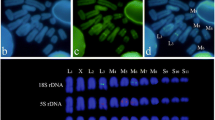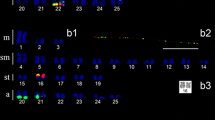Abstract
In spite of the global medical and veterinary importance of Ixodid ticks, relatively little is known about their genome organization. To address this, we developed the first fluorescence in situ hybridization (FISH)-based chromosome markers in the Lyme disease vector, Ixodes scapularis. Shotgun genomic DNA (gDNA) sequences were used to identify three major tandem repeat families which were localized to specific heterochromatic regions of I. scapularis chromosomes prepared from the mitotic cell line ISE18. Together, these repeats were estimated to contribute ∼159 Mb (8%) of the 2.1 Gb (haploid) I. scapularis genome. The relative arrangement of each tandem repeat family and the nucleolar organizing regions was determined by rehybridization to individual chromosome spreads, which was useful to distinguish different chromosomes in the ISE18 karyotype. Long stretches (>20 kb) of tandem repeat-containing gDNA were resistant to digestion by the methylation-sensitive restriction enzyme HpaII and localized to the presumed peri-centromeric regions of the chromosomes. A telomeric probe based on the arthropod-conserved (TTAGG) n tandemly repetitive motif was localized to the termini of each I. scapularis chromosome. Localization of these markers produced the first link between DNA sequences and major structural features of I. scapularis chromosomes and thereby provided the framework for a FISH-based physical map.





Similar content being viewed by others
Abbreviations
- rRNA:
-
ribosomal ribonucleic acid
- DAPI:
-
4′,6-Diamidino-2-phenylindole
- DNA:
-
Deoxyribonucleic acid
- FISH:
-
Fluorescence in situ hybridization
- gDNA:
-
Genomic deoxyribonucleic acid
- ISE18:
-
Ixodes scapularis embryos cell line 18
- ISR:
-
Ixodes scapularis repeat
- NOR:
-
Nucleolar organizing region
- PCR:
-
Polymerase chain reaction
- PBS:
-
Phosphate-buffered saline
- SSC:
-
Saline-sodium citrate
- TBE:
-
Tris-borate-ethylenediaminetetraacetic acid
References
Adams MD, Celniker SE, Holt RA et al (2000) The genome sequence of Drosophila melanogaster. Science 287:2185–2195
Altschul SF, Madden TL, Schäffer AA, Zhang J, Zhang Z, Miller W, Lipman DJ (1997) Gapped BLAST and PSI-BLAST: a new generation of protein database search programs. Nucleic Acids Res 25:3389–3402
Bacon RM, Kugeler KJ, Mead PS (2008) Surveillance for Lyme disease-United States, 1992–2006. CDC Surveillance Summary 57(SS10):1–9
Bass HW, Marshall WF, Sedat JW, Agard DA, Cande WZ (1997) Telomeres cluster de novo before initiation of synapsis: a three dimensional spatial analysis of telomere positions before and during meiotic prophase. J Cell Biol 137:5–18
Bell-Sakyi L, Zweygarth E, Blouin EF, Gould EA, Jongejan F (2007) Tick cell lines: tools for tick and tick-borne disease research. Trends Parasitol 23:450–457
Benson G (1999) Tandem repeats finder: a program to analyze DNA sequences. Nucleic Acids Res 27:573–580
Birchler JA, Gao Z, Han F (2009) A tale of two centromeres-diversity of structure but conservation of function in plants and animals. Funct Integr Genomics 9:7–13
Chen C, Munderloh UG, Kurtti TJ (1994) Cytogenetic characteristics of cell lines from Ixodes scapularis (Acari:Ixodidae). J Med Entomol 31:425–434
Chenna R, Sugawara H, Koike T, Lopez R, Gibson TJ, Higgins DG, Thompson JD (2003) Multiple sequence alignment with the Clustal series of programs. Nucleic Acids Res 31:3497–3500
Dearden P, Donly C, Grbić (2002) Expression of pair-rule gene homologues in a chelicerate: early patterning of the two-spotted spider mite Tetranychus urticae. Development 129:5461–5472
Geraci NS, Johnston JS, Robinson JP, Wikel SK, Hill CA (2007) Variation in genome size of argasid and ixodid ticks. Insect Biochem Mol Biol 37:399–408
Guerrero FD, Nene VM, George JE, Barker SC, Willadsen P (2006) Sequencing a new target genome: the Boophilus microplus (Acari: Ixodidae) genome project. J Med Entomol 43:9–16
Gunn SJ, Hillburn LR (1989) Differential staining of tick chromosomes: techniques for C-banding and silver staining and karyology of Rhipicephalus sanguineus (Latreille). J Parasitol 75:239–245
Gunn SJ, Hilburn LR, Burbach BS (1993) Homology within the X chromosomes of Boophilus microplus (Canestrini) and B. annulatus (Say). J Heredity 84:232–235
Henikoff S, Ahmad K, Malik HS (2001) The centromere paradox: stable inheritance with rapidly evolving DNA. Science 293:1098–1102
Hill CA, Guerrero FD, Van Zee JP, Geraci NS, Walling JG, Stuart JJ (2009) The position of repetitive DNA sequence in the southern cattle tick genome permits chromosome identification. Chromosome Res 17:77–89
Holt RA, Subramanian GM, Halpern A et al (2002) The genome sequence of the malaria mosquito Anopheles gambiae. Science 4:129–149
Ijdo JW, Wells RA, Baldini A, Reeders ST (1991) Improved telomere detection using a telomere repeat probe (TTAGGG) n generated by PCR. Nucleic Acids Res 19:4780
Jensen K, de Miranda Santos IKF, Glass EJ (2007) Using genomic approaches to unravel livestock (host)-tick-pathogen interactions. Trends Parasitol 23:439–444
Jeyaprakash A, Hoy A (2009) The nuclear genome of the phytoseiid Metaseiulus occidentalis (Acari: Phytoseiidae) is among the smallest known in arthropods. Exp Appl Acarol 47:263–273
Jongejan F, Uilenberg G (2004) The global importance of ticks. Parasitology 129:S3–S14
Jongejan F, Nene V, de la fuente J, Pain A, Willadsen P (2007) Advances in the genomics of ticks and tick-borne pathogens. Trends Parasitol 23:391–396
Lander ES, Linton LM, Birren B, International Human Genome Sequencing Consortium et al (2001) Initial sequencing and analysis of the human genome. Nature 409:860–921
LeBel C, Wellinger RJ (2005) Telomeres: what’s new at your end? J Cell Sci 118:2785–2788
Lejnine S, Makarov VL, Langmore J (1995) Conserved nucleoprotein structure at the ends of vertebrate and invertebrate chromosomes. Proc Natl Acad Sci USA 92:2393–2397
Levinson G, Gutman GA (1987) Slipped-strand mispairing: a major mechanism for DNA sequence evolution. Mol Biol Evol 4:203–221
Lohe AR, Hilliker AJ (1995) Return of the H-word (heterochromatin). Curr Opin Genet Dev 5:746–755
Loidl J (1990) The initiation of meiotic chromosome pairing: the cytological view. Genome 33:759–778
Lorite P, Carrillo JA, Palomeque T (2002) Conservation of (TTAGG) n telomeric sequences among ants (Hymenoptera, Formicidae). J Heredity 93:282–285
Luo S, Hall AE, Hall SE, Preuss D (2004) Whole-genome fractionation rapidly purifies DNA from centromeric regions. Nature Met 1:1–5
Meyne J, Hirai H, Imai T (1995) FISH analysis for the telomere sequences of bulldog ants (Myrmecia: Formicidae). Chromosoma 104:14–18
Munderloh UG, Liu Y, Wang M, Chen C, Kurtti TJ (1994) Establishment, maintenance and description of cell lines from the tick Ixodes scapularis. J Parasitol 80:533–543
Nene V, Wortman JR, Lawson D et al (2007) Genome sequence of Aedes aegypti, a major arbovirus vector. Science 316:1718–1723
Okazaki S, Tsuchida K, Maekawa H, Ishikawa H, Fujiwara H (1993) Identification of a pentanucleotide telomeric sequence, (TTAGG) n, in the silkworm Bombyx mori and in other insects. Mol Cell Biol 13:1424–1432
Oliver JH (1977) Cytogenetics of mites and ticks. Ann Rev Entomol 22:407–429
Oliver JH, Owsley MR, Hutcheson HJ, James AM, Chen C, Irby WS, Dotson EM, Mclain DK (1993) Conspecificity of the ticks Ixodes scapularis and I. dammini (Acari: Ixodidae). J Med Entomol 30:54–63
Plohl M, Bortsnik B, Lucijanić-Justić V, Ugarković D (1992) Evidence for random distribution of sequence variants in Tenebrio molitor satellite DNA. Genet Res 61:7–13
Rovira C, Beermann W, Edström JE (1993) A repetitive DNA sequence associated with the centromeres of Chironomus pallidivittatus. Nucleic Acids Res 21:1775–1781
Sahara K, Marec F, Traut W (1999) TTAGG telomeric repeats in chromosomes of some insects and other arthropods. Chromosome Res 7:449–460
Scherthan H, Bähler J, Kohli J (1994) Dynamics of chromosome organization and pairing during meiotic prophase in fission yeast. J Cell Biol 127:273–285
Scherthan H, Weich S, Schwegler H, Heyting C, Härle M, Cremer T (1996) Centromere and telomere movements during early meiotic prophase of mouse and man are associated with the onset of chromosome pairing. J Cell Biol 134:1109–1125
Schwarzacher HG, Wachtler F (1983) Nucleolus organizer regions and nucleoli. Hum Genet 63:88–99
Shapiro JA (2002) Repetitive DNA, genome system architecture and genome reorganization. Res Microbiol 153:447–453
Spence JM, Blackman RL, Testa JM, Ready PD (1998) A 169-base pair tandem repeat DNA marker for subtelomeric heterochromatin and chromosomal rearrangements in aphids of the Myzus persicae group. Chromosome Res 6:167–175
Stratikopoulos EE, Augustinos AA, Gariou-Papalexiou A, Zacharopoulou A, Mathiopoulos KD (2002) Identification and partial characterization of a new Ceratitis capitata-specific 44-bp pericentromeric repeat. Chromosome Res 10:287–295
Ugarković D, Podnar M, Plohl M (1996) Satellite DNA of the red flour beetle Tribolium castaneum-comparative study of satellites from the genus Tribolium. Mol Biol Evol 13:1059–1066
Ullmann AJ, Piesman J, Dolan MC, Black WC IV (2002) A preliminary linkage map of the tick, Ixodes scapularis. Exp Appl Acarol 28:107–126
Ullmann AJ, Lima CM, Guerrero FD, Piesman J, Black WC 4th (2005) Genome size and organization in the blacklegged tick, Ixodes scapularis and the southern cattle tick, Boophilus microplus. Insect Mol Biol 14:217–222
Van Zee JP, Geraci NS, Guerrero FD, Wikel SK, Stuart JJ, Nene VM, Hill CA (2007) Tick genomics: the Ixodes genome project and beyond. Intl J Parasitol 37:1297–1305
Villasante A, Abad JP, Planelló R, Méndez-Lago M, Celniker SE, de Pablos B (2007) Drosophila telomeric retrotransposons derived from an ancestral element that was recruited to replace telomerase. Genome Res 17:1909–1918
Vítková M, Král J, Traut W, Zrzavy J, Marec F (2005) The evolutionary origin of insect telomeric repeats, (TTAGG)n. Chromosome Res 13:145–156
Yuan Y, SanMiguel PJ, Bennetzen JL (2003) High-Cot sequence analysis of the maize genome. Plant J 24:249–255
Yunker CE, Cory J, Meibos H (1981) Continuous cell lines from embryonic tissues of ticks (Acari: Ixodidae). In Vitro 17:139–142
Acknowledgements
The authors thank S. Jackson and J. Stewart for their helpful review comments on the manuscript. This research was supported by the NIAID contract HHS2662004000396 (VectorBase contract) to C.A. Hill and the Indiana 21st Century Research and Technology Fund to C.A. Hill.
Author information
Authors and Affiliations
Corresponding author
Additional information
Responsible Editor: Hans-Joachim Lipps
Rights and permissions
About this article
Cite this article
Meyer, J.M., Kurtti, T.J., Van Zee, J.P. et al. Genome organization of major tandem repeats in the hard tick, Ixodes scapularis . Chromosome Res 18, 357–370 (2010). https://doi.org/10.1007/s10577-010-9120-4
Received:
Accepted:
Published:
Issue Date:
DOI: https://doi.org/10.1007/s10577-010-9120-4




